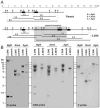An insertional trap for conditional gene expression in Toxoplasma gondii: identification of TAF250 as an essential gene
- PMID: 21035508
- PMCID: PMC3053073
- DOI: 10.1016/j.molbiopara.2010.10.007
An insertional trap for conditional gene expression in Toxoplasma gondii: identification of TAF250 as an essential gene
Abstract
Toxoplasmosis is characterized by fast lytic replication cycles leading to severe tissue lesions. Successful host cell invasion is essential for pathogenesis. The division cycle of Toxoplasma gondii is characterized by an unusual cell cycle progression and a distinct internal budding mechanism. To identify essential genes involved in the lytic cycle we devised an insertional gene trapping strategy using the Tet-transactivator system. In essence, a random, active promoter is displaced with a tetracycline regulatable promoter, which if in an essential gene, will result in a conditionally lethal phenotype upon tetracycline addition. We isolated eight mutants with growth defects, two of which displayed modest invasion defects, one of which had an additional cell cycle defect. The trapped loci were identified using expression microarrays, exploiting the tetracycline dependent expression of the trapped genes. In mutant 3.3H6 we identified TCP-1, a component of the chaperonin protein folding machinery under the control of the Tet promoter. However, this gene was not critical for growth of mutant 3.3H6. Subsequently, we identified a suppressor gene encoding a protein with a hypothetical function by guided cosmid complementation. In mutant 4.3B13, we identified TAF250, an RNA polymerase II complex component, as the trapped, essential gene. Furthermore, by mapping the plasmid insertion boundaries we identified multiple genomic rearrangements, which hint at a potential replication dependent DNA repair mechanism. Furthermore, these rearrangements provide an explanation for inconsistent locus rescue results observed by molecular biological approaches. Taken together, we have added an approach to identify and study essential genes in Toxoplasma.
Copyright © 2010 Elsevier B.V. All rights reserved.
Figures







Similar articles
-
A tetracycline-repressible transactivator system to study essential genes in malaria parasites.Cell Host Microbe. 2012 Dec 13;12(6):824-34. doi: 10.1016/j.chom.2012.10.016. Cell Host Microbe. 2012. PMID: 23245327 Free PMC article.
-
A genetic screen to isolate Toxoplasma gondii host-cell egress mutants.J Vis Exp. 2012 Feb 8;(60):3807. doi: 10.3791/3807. J Vis Exp. 2012. PMID: 22349295 Free PMC article.
-
Genetic manipulation of the Toxoplasma gondii genome by fosmid recombineering.mBio. 2014 Dec 2;5(6):e02021. doi: 10.1128/mBio.02021-14. mBio. 2014. PMID: 25467441 Free PMC article.
-
Advantages and disadvantages of conditional systems for characterization of essential genes in Toxoplasma gondii.Parasitology. 2014 Sep;141(11):1390-8. doi: 10.1017/S0031182014000559. Epub 2014 Jun 13. Parasitology. 2014. PMID: 24926834 Review.
-
A toolbox for conditional control of gene expression in apicomplexan parasites.Mol Microbiol. 2022 Mar;117(3):618-631. doi: 10.1111/mmi.14821. Epub 2021 Oct 13. Mol Microbiol. 2022. PMID: 34564906 Free PMC article. Review.
Cited by
-
Forward genetics screens using macrophages to identify Toxoplasma gondii genes important for resistance to IFN-γ-dependent cell autonomous immunity.J Vis Exp. 2015 Mar 12;(97):52556. doi: 10.3791/52556. J Vis Exp. 2015. PMID: 25867017 Free PMC article.
-
Lysine acetyltransferase GCN5b interacts with AP2 factors and is required for Toxoplasma gondii proliferation.PLoS Pathog. 2014 Jan;10(1):e1003830. doi: 10.1371/journal.ppat.1003830. Epub 2014 Jan 2. PLoS Pathog. 2014. PMID: 24391497 Free PMC article.
-
The Toxoplasma gondii centrosome is the platform for internal daughter budding as revealed by a Nek1 kinase mutant.J Cell Sci. 2013 Aug 1;126(Pt 15):3344-55. doi: 10.1242/jcs.123364. Epub 2013 May 31. J Cell Sci. 2013. PMID: 23729737 Free PMC article.
-
Function and regulation of a steroidogenic CYP450 enzyme in the mitochondrion of Toxoplasma gondii.PLoS Pathog. 2023 Aug 31;19(8):e1011566. doi: 10.1371/journal.ppat.1011566. eCollection 2023 Aug. PLoS Pathog. 2023. PMID: 37651449 Free PMC article.
-
The Toxoplasma gondii calcium-dependent protein kinase 7 is involved in early steps of parasite division and is crucial for parasite survival.Cell Microbiol. 2014 Jan;16(1):95-114. doi: 10.1111/cmi.12186. Epub 2013 Sep 9. Cell Microbiol. 2014. PMID: 24011186 Free PMC article.
References
-
- Montoya JG, Liesenfeld O. Toxoplasmosis. Lancet. 2004;363:1965–1976. - PubMed
-
- Gubbels MJ, White M, Szatanek T. The cell cycle and Toxoplasma gondii cell division: Tightly knit or loosely stitched? Int J Parasitol. 2008;38:1343–1358. - PubMed
-
- White MW, Radke J, Conde de Felipe M, Lehmann M. Cell cycle control/parasite division. Horizon Scientific Press; Norwich, UK: 2007.
-
- Meissner M, Schluter D, Soldati D. Role of Toxoplasma gondii myosin A in powering parasite gliding and host cell invasion. Science. 2002;298:837–840. - PubMed
Publication types
MeSH terms
Substances
Grants and funding
LinkOut - more resources
Full Text Sources

